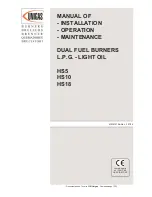
7
Figure 5A. Pilot Assembly – Flame Rod Type – Natural Gas/LP Gas – NPM15 – NPM50 – 120 Volt
7.11
With the leak gas cock closed and pilot gas cock open; turn the burner switch ON. The blower motor will
purge the heat exchanger of
any accumulated combustibles
. At the end of the purge cycle, the pilot
solenoid valve will energize and spark will be initiated. The pilot will attempt to light for 10 seconds (15
seconds with S8680 control). Adjust the pilot pressure at this time. If the pilot fails to light, lockout will
occur.
Note:
If using the S8680 control power must be removed for 60 seconds to allow it to reset.
7.12
Pilot Adjustment and Main Flame Light Off Procedure
A.
Set the air damper and adjust the pilot regulator gas pressure in order to provide instant pilot
ignition, good flame stability, and a strong/steady signal reading. Connect a DC voltmeter or
microampmeter to the flame safeguard control as appropriate to determine flame detection
system signal values. Refer to Table 3.
B.
Adjust the pilot regulator to obtain approximately 0.5” to 1.0” W.C. pressure at the pilot test port.
Note: This pressure varies depending on the damper opening/burner model. The actual pilot gas
pressures will typically be 0.5” to 0.1” W.C. above the static air pressure as seen on the gage
before the pilot valve opens. Further pressure adjustments may be necessary to obtain the best
pilot operating point.
C.
After attaining the proper pilot flame signal values, cycle the pilot on and off several times in order
to ensure reliability (with the gas leak test cock still closed).
Turn Burner Switch Off
.
D.
Having established pilot reliability, open gas leak test cock.
Table 3. Acceptable Pilot and/or Main Flame Current Readings
CONTROL
FLAME ROD
RM78XX series
1.25-5 VDC
Fireye E series
10 min/20 normal
S8680J
1.5 Microamps































